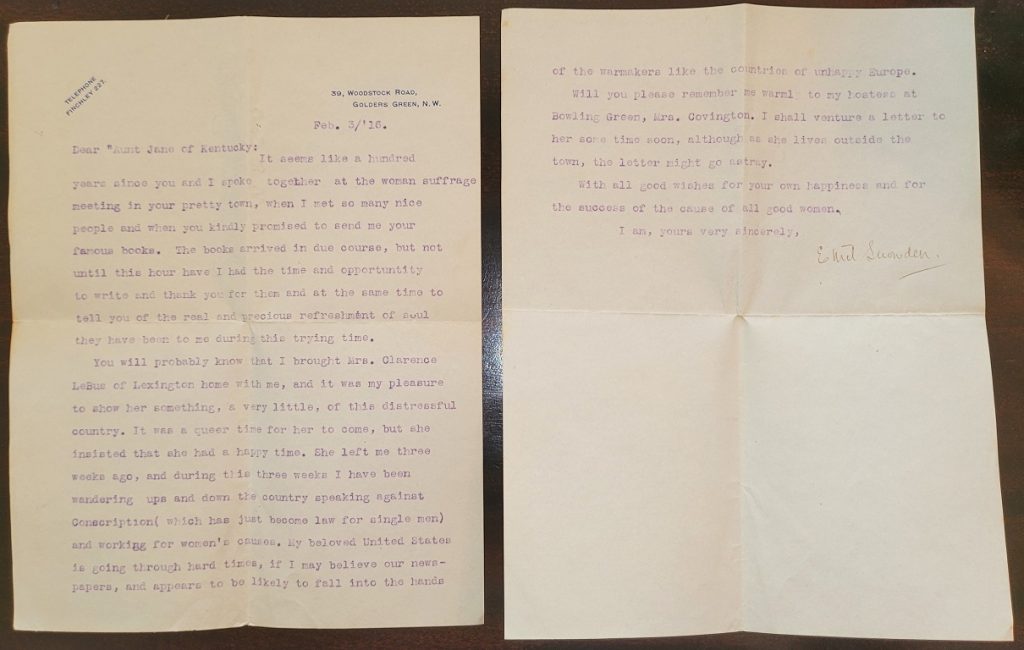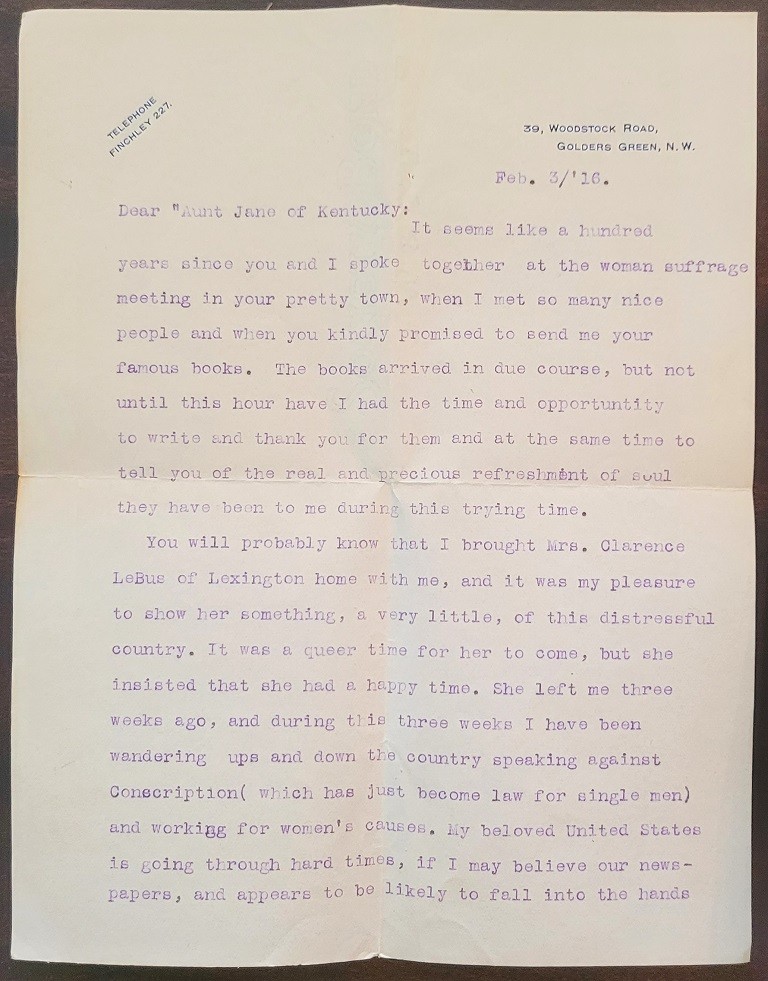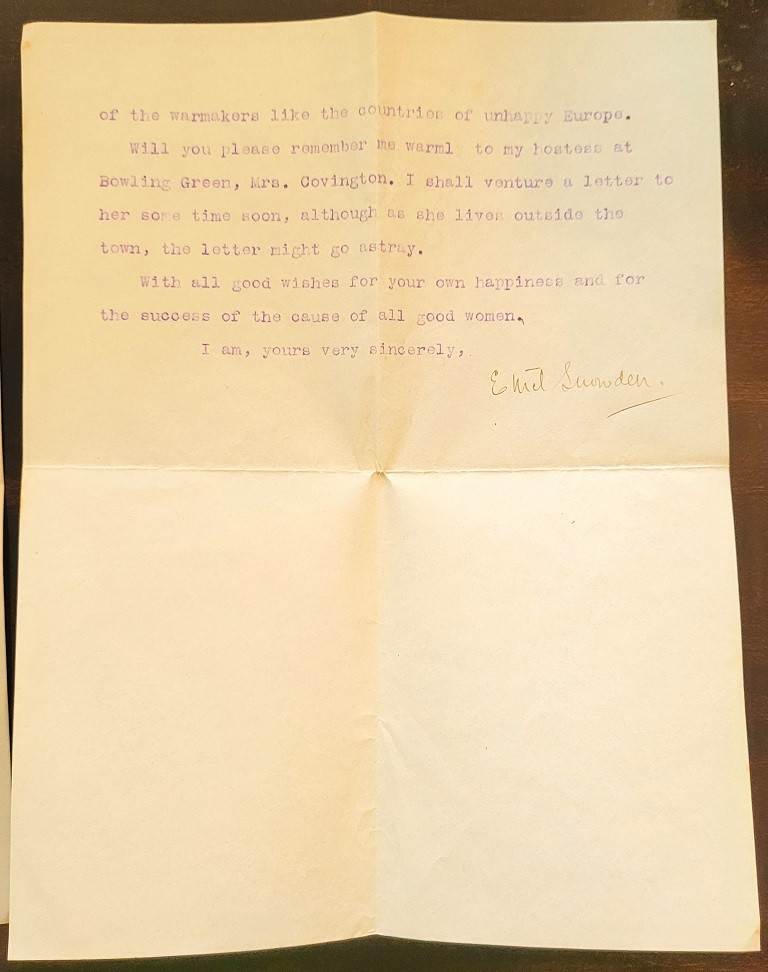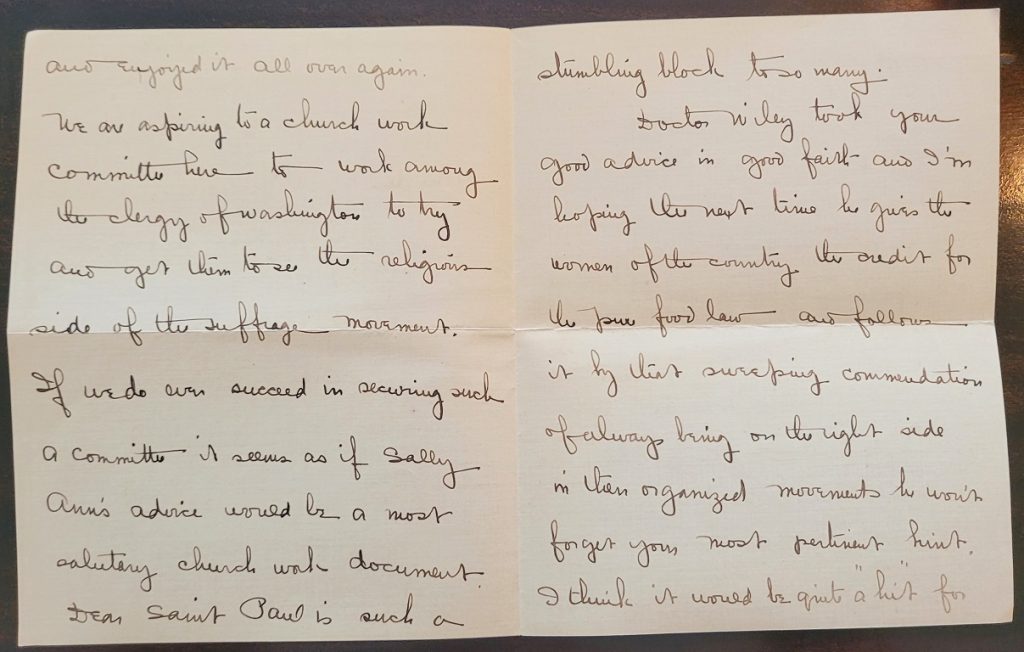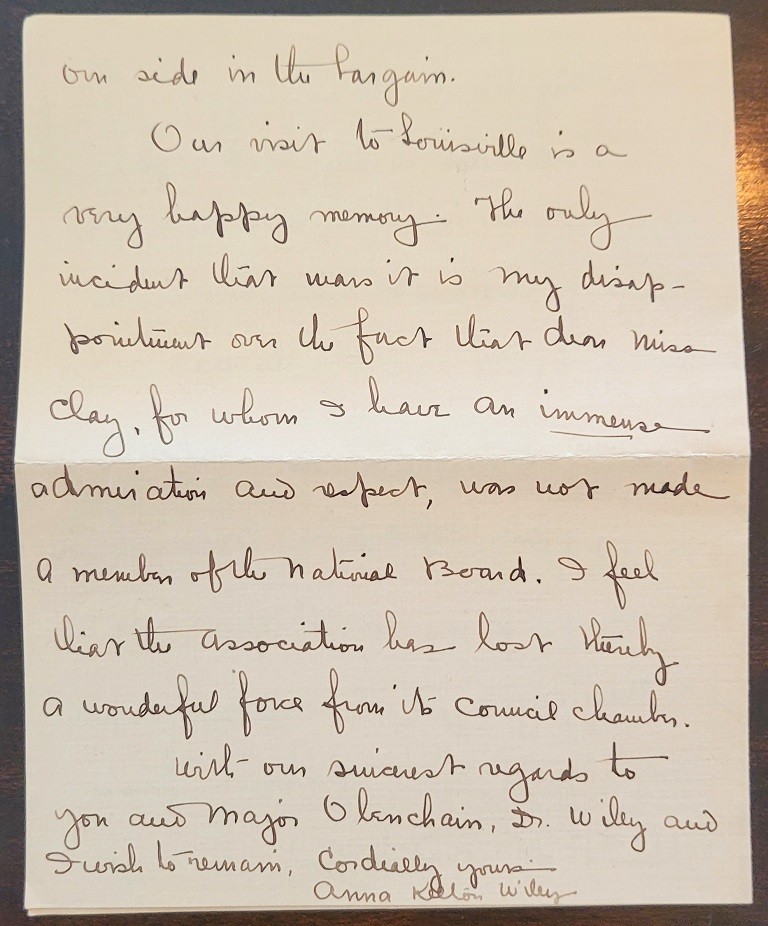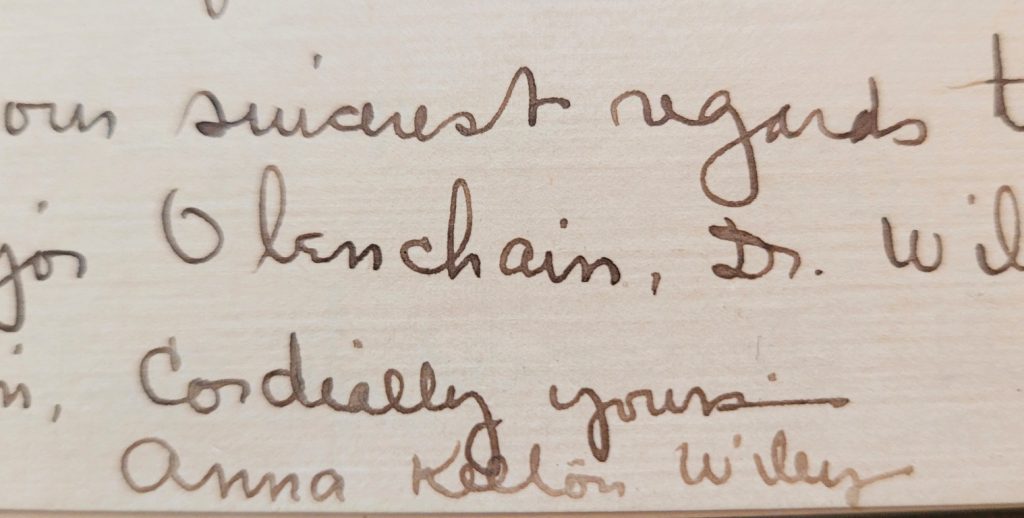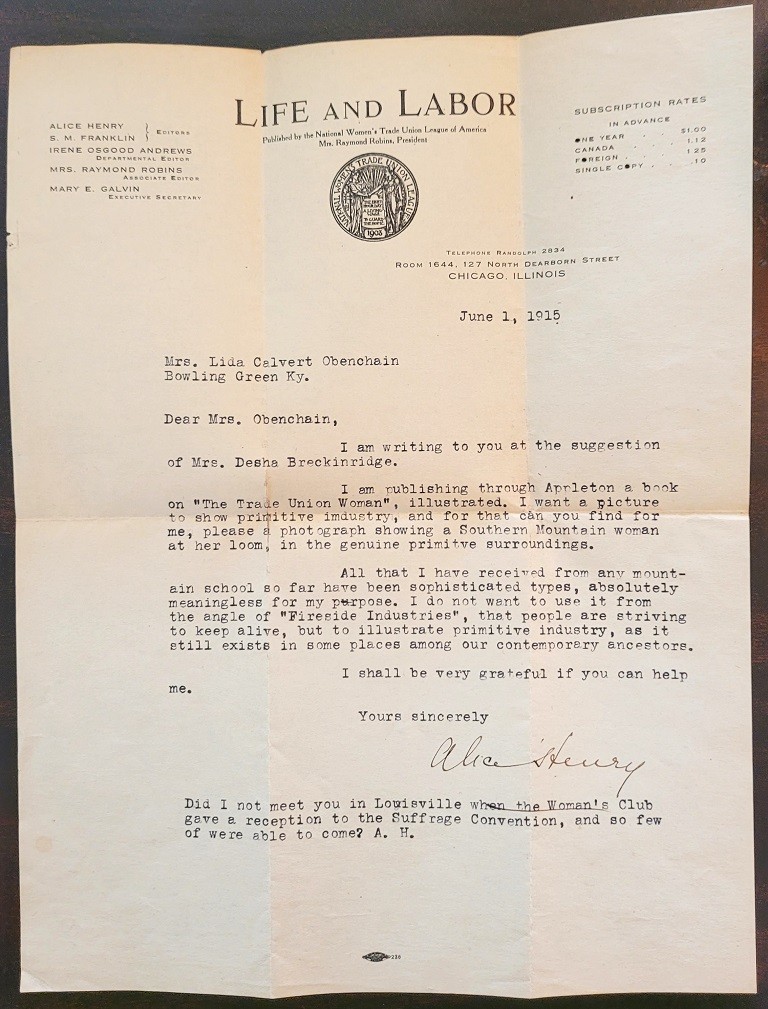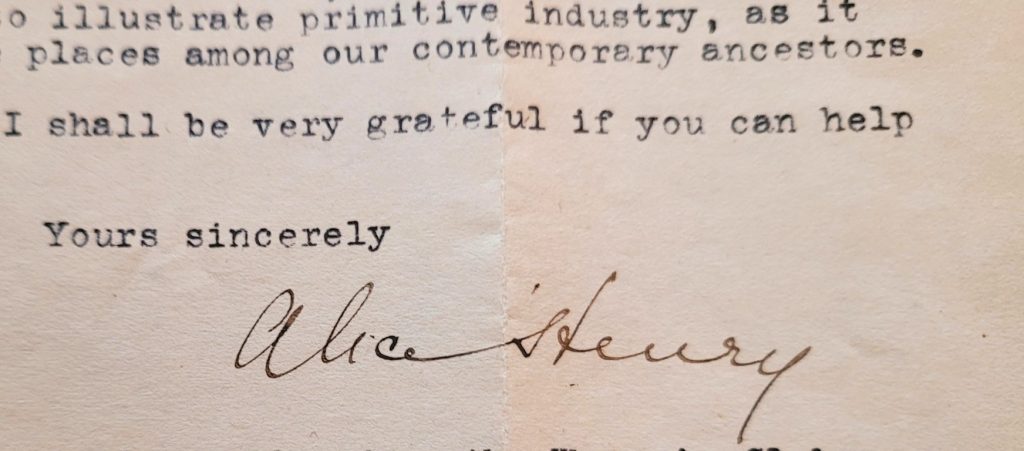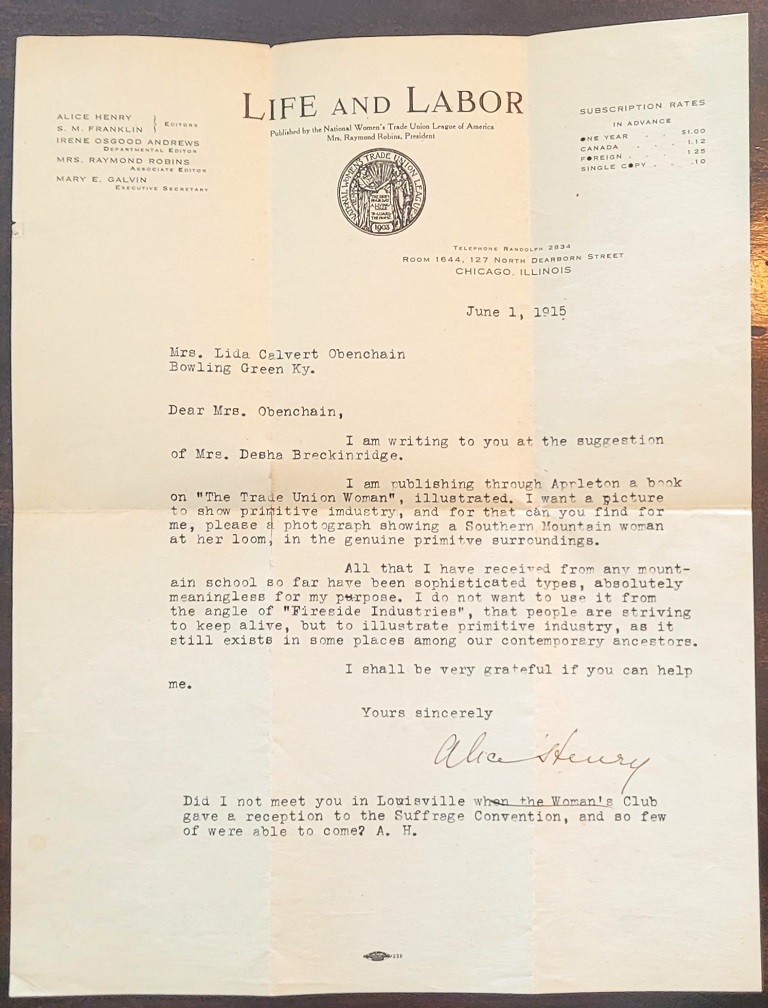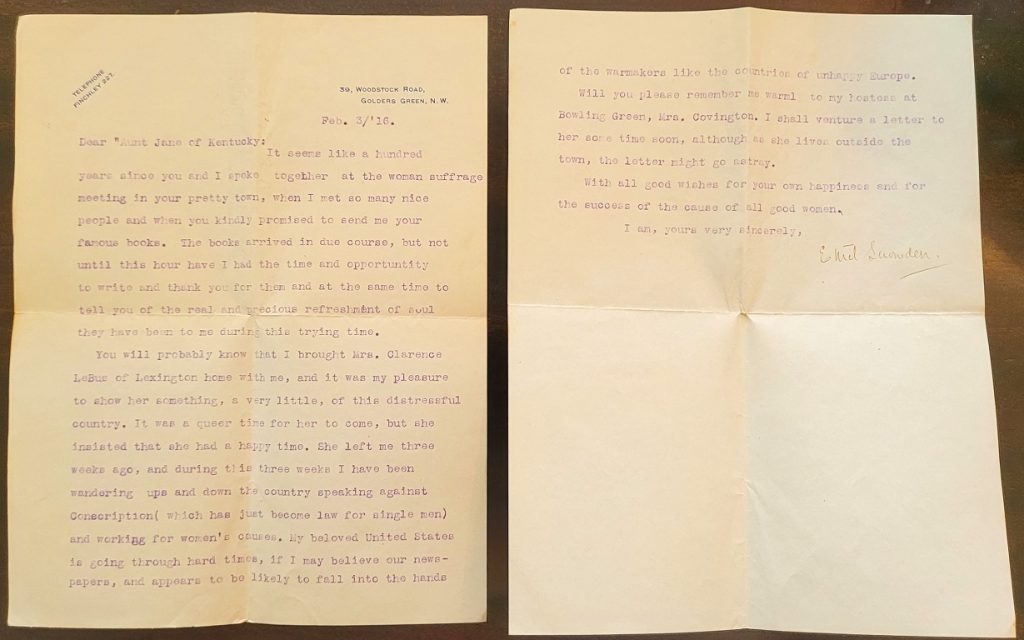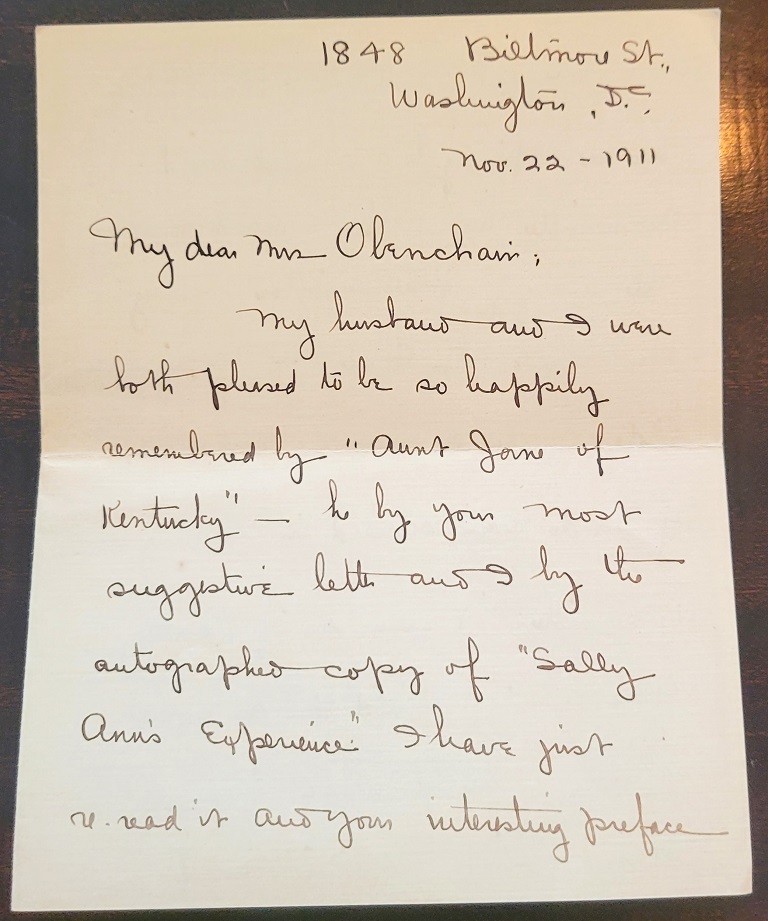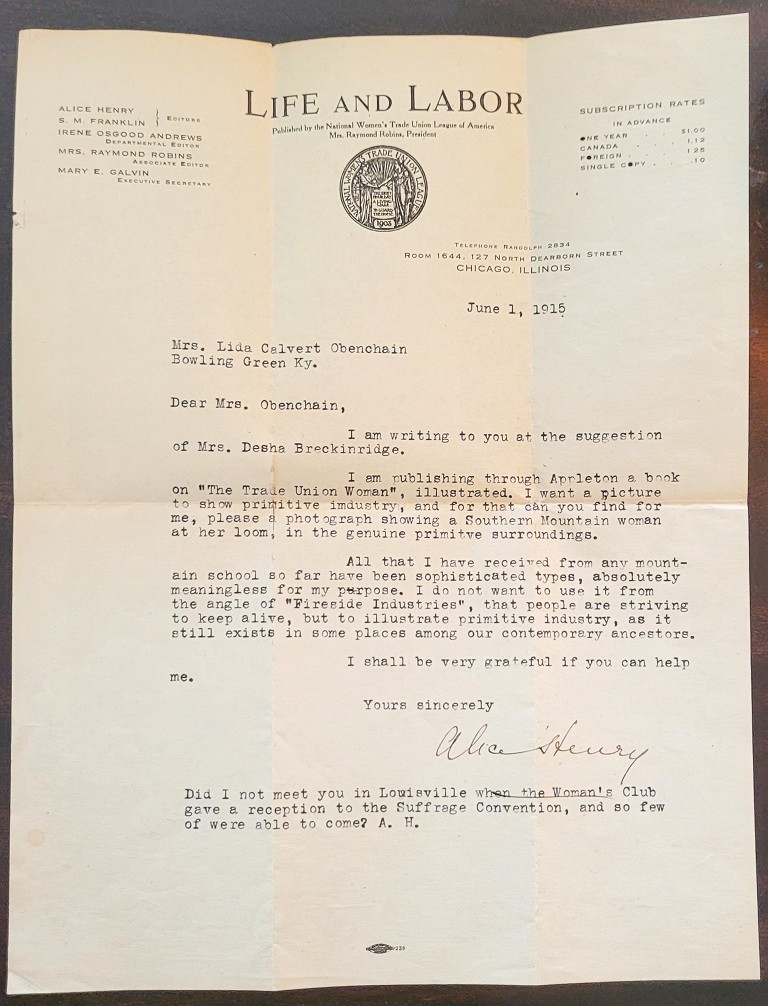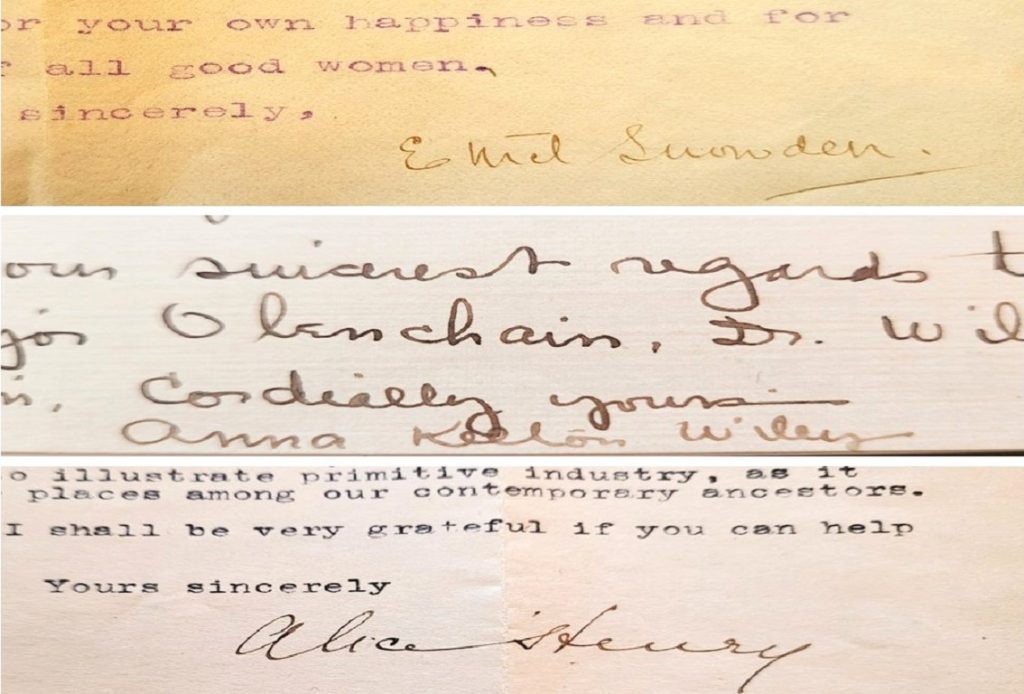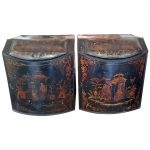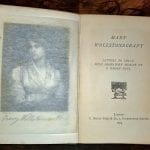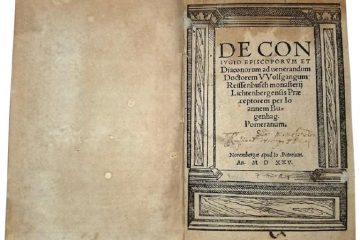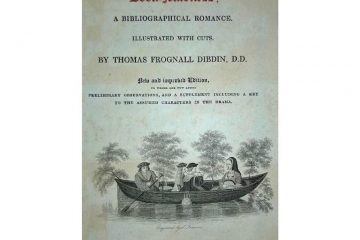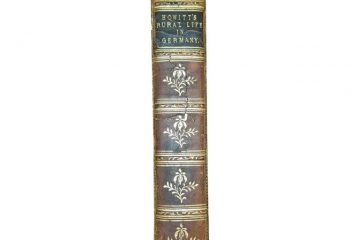Collection of 3 Letters from 3 Major Figures in the Early 20C Suffrage Movement – Snowden, Henry and Wiley
PRESENTING A FABULOUS and HISTORIC Collection of 3 Letters from 3 Major Figures in the Early 20C Suffrage Movement – Snowden, Henry and Wiley.
The Collection consists of:
(1) Typed and personally Signed Letter from Ethel Snowden dated 3 Feb 1916 to Eliza Calvert Hall/Aunt Jane of Kentucky. The letter consists of 2 typed pages on personal stationary, headed ” 39 Woodstock Road, Golders Green, N.W. (London) … Telephone: Finchley 227″.
This is the best letter of the collection, as Mrs Snowden it probably the best known of the 3 and it references her speaking tours against WW1 Conscription, women’s rights and politics.
She was also one of the most famous pioneers of the Suffrage Movement, both in the UK and US.
(2) Hand written and signed Letter from Anna Kelton Wiley dated 22 Nov 1911 to Mrs Obenchain (Eliza Calvert Hall). The letter consists of a double folio with writing on both sides. It is headed: “1848 Biltmore St., Washington, DC”.
This letter is great because it is entirely hand-written by the author, signed and dated but it also references opinions and strategies for the Women’s Rights/Suffrage Movement.
(3) Typed and personally signed Letter from Alice Henry dated 1 June 1915 on ‘Life and Labor” headed stationary. The letter consists of a single folio with writing on one side only.
The letter was written at the Life and Labor Offices in Chicago, Illinois of which Alice Henry was co-Editor.
This letter is also great because of the author, the stationary and it’s importance to the advancement of the Women’s Rights Movement at that time and it’s reference to Ms. Henry’s upcoming book “The Trade Union Woman’. It’s post script, also references the Suffrage Convention meeting in Louisville, KY.
On a point of interest: Ms. Henry did receive a picture of a ‘Southern mountain woman at her loom’ which appears in the published book. It is accredited to ‘The Pine Mountain Settlement’ in Kentucky. We cannot say for certain that Eliza Calvert Hall organized this for her, but there is a very good chance that she used her connections in Bowling Green to get it for Alice!
Ethel Snowden, Viscountess Snowden (born Ethel Annakin; 8 September 1881 – 22 February 1951), was a British socialist, human rights activist, and feminist politician. From a middle-class background, she became a Christian Socialist through a radical preacher and initially promoted temperance and teetotalism in the slums of Liverpool. She aligned to the Fabian Society and later the Independent Labour Party, earning an income by lecturing in Britain and abroad. Snowden was one of the leading campaigners for women’s suffrage before the First World War, then founding The Women’s Peace Crusade to oppose the war and call for a negotiated peace. After a visit to the Soviet Union she developed a strong criticism of its system, which made her unpopular when relayed to the left-wing in Britain.
Snowden married the prominent Labour Party politician and future Chancellor of the Exchequer, Philip Snowden. She rose up the social scale in the 1920s, much to her pleasure, and she welcomed appointment as a Governor of the BBC and as a Director of the Royal Opera House. Although her husband received a Viscountcy, money became tight and she led the way in caring for him; after his death, she resumed temperance campaigning as well as journalism. She tended to be a controversial public speaker, who would fill with enthusiasm for a project and pursue it to the disregard of anything that stood in her way; it was said of her that “tact or discretion were foreign to her nature”
Link: https://en.wikipedia.org/wiki/Ethel_Snowden
Many heroines from the suffragist movement made the right for women to vote for the first time in 1920 possible after ratification of the 19th Amendment for Equal Rights. This writing relates the story of only one of those women, Anna Kelton Wiley.
Born March 8, 1877 in Oakland, California to John and Josephine Kelton, Anna was one of five children listed on the 1880 federal census of San Francisco, California. Two more children were born after Anna. The 1900 federal census gives the information that eight children were born to Josephine and at that time seven were living. John Kelton, shown on the 1880 census as a soldier, lived with his family in barracks in San Francisco. The family must have had some means as Josephine’s mother and four servants were living in their household.
By the 1900 census John had passed away and widow Josephine Kelton headed the family in Washington, D.C. with six of her children residing with her (one of whom was Anna), both of Josephine’s parents and a housekeeper. In the meantime Anna had graduated from George Washington University, Washington, D.C. in 1892 and worked as a government clerk. In1910 she worked as a library clerk, still living in her mother’s household.
On February 27, 1911 Anna Kelton and Harvey W. Wiley, a confirmed bachelor, were united in marriage in Washington, D. C. Anna was thirty-three and Harvey was sixty-six. It was a first marriage for both of them. Harvey, a noted chemist best known for his leadership in the passage of the landmark Pure Food and Drug Act of 1906, was nicknamed the “Father of the Pure Food and Drug Act”. They were the parents of two sons, Harvey Jr. and John.
Theirs is a great love story. While working in a laboratory at Harvard University in 1873 where Harvey completed his B.S. degree, he wrote a poem “Chemico Metrical Madrigal.” In the poem he paid tribute to a blond, blue-eyed ideal of feminine beauty in images drawn from chemistry and in four-line rhyming stanzas. His vision of the woman he was looking for was so compelling that he waited for her another twenty-five years. He first saw Anna Kelton in 1898.
Suffrage women picketed the White House in 1917. That summer President Woodrow Wilson’s government began arresting members of the National Woman’s party for demonstrating for the right to vote. Over 100 were arrested and jailed between 1917 and 1919. Looking like the perfect lady dressed up in white with hat, Anna Wiley was photographed holding on to a sign which read, “MR. PRESIDENT – HOW LONG MUST WOMEN WAIT FOR LIBERTY.” In a 1918 Good Housekeeping article they explained why they picketed the White House as, “Finding our amendment blocked at every turn on the road [and] refused further audiences by the President, we determined to lay the responsibility for the indifference of Congress to our amendment where it belonged, upon the leader of the party in power.”
Anna Kelton Wiley, a member of the National Woman’s Party (NWP)’s national advisory council, was active in lobbying, political work, and picketing for NWP. She spent 5 days in district jail when she was arrested and sentenced to 15 days on November 10, 1917. Wiley appealed her case and it was later upheld by a higher court. She could have been pardoned, but chose to go to jail so Elizabeth McShane would not have to go alone. Later Wiley said that the “jailing was the highlight of my life.”
After Harvey Wiley’s long government career he resigned a year after his marriage and took over the laboratories of Good Housekeeping magazine where he worked for 18 years. He died at his home in Washington, D.C. on June 30, 1930, the 24th anniversary of the signing of the Pure Food and Drug law. He was buried in Arlington National Cemetery. Wiley left quite a legacy and has been honored in a number of ways since his passing.
Anna Kelton Wiley continued her activity in various Washington organizations after Harvey’s death. She served as Chairman of the NWP (1930-1932, 1940-1942) and was editor (1940-1945) of its periodical, Equal Rights. She continued the fight both she and her husband were engaged in for improved consumer health and safety in relation to food, drug and beverage products on the market. For fifty-five years she was active in various Washington organizations, belonging to more than 40 of them. She used her knowledge of and interest in politics and lobbied for legislation on their behalf.
Anna Kelton Wiley died in 1964 and is buried in Arlington Cemetery next to her husband.
Link: https://suffragistmemorial.org/anna-kelton-wiley-suffragist/
Alice Henry (21 March 1857 – 14 February 1943) was an Australian suffragist, journalist and trade unionist who also became prominent in the American trade union movement as a member of the Women’s Trade Union League.
Henry Street in the Canberra suburb of Cook is named in her honour.
The Women’s Trade Union League (WTUL) was established in 1903 and consisted of reformers seeking to combine trade unionism and feminism to create a new force towards the obstacles women faced when organising women into unions. In Henry’s 1915 essay “A Separate Piece” published in The Trade Union Woman she discussed some of the problems associated with organising. One of the issues she addressed was the tension between middle-class reformers of the WTUL and the working-class women. A possible solution that she advocated was the establishment of separate women’s locals.
Henry’s background with Fabian socialism, as well as her knowledge of Australian labour legislation and woman suffrage attracted the attention of Margaret Dreier Robins, a prominent reformer of the time. Henry was invited by Robins to work for the National Women’s Trade Union League of America in Chicago as a lecturer and field-worker. As a field worker Henry organised new branches, and as a journalist she became a key figure and voice in the campaign for ‘woman suffrage, union organisation, vocational education, and labour legislation.’
Between 1907 and 1925 Henry served as an editor, publicist and lecturer for the WTUL. Henry played an active role in mobilising both the middle class as well as trade union support for the League’s legislative, educational and organizational goals. As an activist she participated in many clubs such as the Melbourne Shakespeare Society, was secretary of the Women Writer’s Club, lectured and frequently at women’s organisations (like the Prahran and Kew Progressive League). Alice also served as an advisory member on committees set up by the National Council of Women and the Victorian Women’s Federation. It is important to note that she was not a leader or organiser of the women’s movement rather she worked as a prominent publicist within it. Life and Labor was the journal of the National Women Trade Union League. It was published in Chicago and effectively promoted women’s suffrage.
On 19 May 1911 a suffrage meeting was held at The Pfister Hotel club room, there Henry urged that the best ways to obtain result was to carry out a campaign along intensive lines. There she advocated for street meetings to create interest in the suffrage cause. Henry said,
“Many persons will stop to listen at a street meeting who would not come to a suffrage meeting…The talks should be short about five minutes for those who are attracted will only pause for a few moments and a long speech would be lost on them. Any ready speaker would do.” hi Henry had the ability to captivate American audiences when she spoke due to her conviction and energy she exuded. Henry saw current legislation and policy as not helping. “I do not feel that the vote is any sort of advance for women. If you give suffrage to men and not women you are putting women on a relatively lower plane. Society will go backward if women don’t get to vote.”
Through her own personal experience in Australia she said that women’s suffrage there had resulted in a more positive shift in attitudes toward women in the industry. She cited that wages and factory conditions have improved and that in general industries had become more humanised. Henry did admit that the women had not been the only factor in these changes but that the increased power in women had a materially role in aiding these changes.
Link: https://en.wikipedia.org/wiki/Alice_Henry
Collection of 3 Letters from 3 Major Figures in the Early 20C Suffrage Movement – Snowden, Henry and Wiley
Provenance: From the Estate of Eliza Calvert Hall
Condition: All 3 letters are in very good condition. Fold marks but no tears. Some minor yellowing of the paper with age. Stored in an acid free plastic bag.
Dimensions:
Snowden Letter: Each of the 2 pages is 9″ x 7″
Wiley Letter: 6.3″ x 5.2″
Henry Letter: 10.8″ x 8.5″
SALE PRICE NOW: $4,000 (Set of 3)
